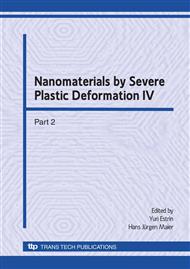p.269
p.275
p.281
p.287
p.293
p.300
p.306
p.310
p.315
Shear Induced Low- and High-Angle Boundary Characterization Using Kikuchi Bands in Transmission Electron Microscopy
Abstract:
Microstructure evolution with equal channel angular pressing (ECAP) using route Bc, that is a 90° axial rotation of the billet between passes, up to 8 passes, was investigated by transmission electron microscopy. The study has been focused on the induced development of boundary misorientation and spacing toward microstructure refinement. Cell (low-angle) and grain (high-angle) misorientation and spacing were determined from about 250 boundaries per pass of ECAP, systematically using whether Kikuchi patterns or Moiré fringes, these latter where possible. The average cell size and misorientation saturate within the first two passes. Misorientation and spacing of high-angle boundaries decrease with the number of passes. After 8 passes, mean cell size is ≈ 1.3 µm and the fraction of high-angle boundaries is ≈ 0.7. Differences in rate of grain structure evolution per pass are linked to differences in ability of dislocations introduced in new passes to recombine with the existing ones. As ECAP strain rises, the misorientation distribution develops strong deviations from the MacKenzie distribution for statistical grain orientation. This is interpreted as a result of the tendency to form equiaxed grains in a textured grain structure.
Info:
Periodical:
Pages:
293-299
Citation:
Online since:
June 2008
Authors:
Price:
Сopyright:
© 2008 Trans Tech Publications Ltd. All Rights Reserved
Share:
Citation:


